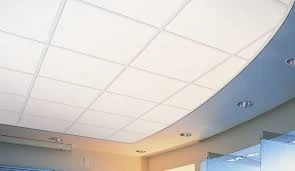- Afrikaans
- Albanian
- Amharic
- Arabic
- Armenian
- Azerbaijani
- Basque
- Belarusian
- Bengali
- Bosnian
- Bulgarian
- Catalan
- Cebuano
- Corsican
- Croatian
- Czech
- Danish
- Dutch
- English
- Esperanto
- Estonian
- French
- German
- Greek
- Hindi
- Indonesian
- irish
- Italian
- Japanese
- Korean
- Lao
- Malay
- Myanmar
- Norwegian
- Norwegian
- Polish
- Portuguese
- Romanian
- Russian
- Serbian
- Spanish
- Swedish
- Thai
- Turkish
- Ukrainian
- Uzbek
- Vietnamese
11月 . 04, 2024 11:59 Back to list
Specifications for Mineral Fiber Ceiling Products and Installation Guidelines
Understanding Mineral Fiber Ceiling Specifications
Mineral fiber ceilings, also known as acoustic ceilings or suspended ceilings, play a crucial role in modern building design, providing aesthetic appeal, sound absorption, and thermal insulation. Made primarily from mineral-based materials such as gypsum, fiberglass, or recycled paper, these ceilings are particularly favored in commercial and industrial settings. Their performance and specifications are paramount for architects and builders in ensuring they meet both functional and regulatory standards.
Key Characteristics of Mineral Fiber Ceilings
1. Acoustic Performance One of the primary advantages of mineral fiber ceilings is their ability to control sound. These materials are designed to absorb sound waves, reducing noise levels within a space. This is particularly important in environments like offices, schools, and hospitals where noise control is essential for productivity and comfort. The Noise Reduction Coefficient (NRC) is a critical metric here, with higher values indicating better sound absorption.
2. Fire Resistance Safety is a top priority in building design, and mineral fiber ceilings are inherently fire-resistant due to their mineral composition. Many products achieve high fire ratings, making them suitable for commercial spaces requiring strict adherence to fire safety regulations. The Fire Classification rating, such as Class A, indicates their suitability in fire-prone environments.
3. Moisture Resistance In areas prone to humidity, such as kitchens and bathrooms, moisture-resistant mineral fiber ceilings are essential. Specifications often include treatments that prevent mold and mildew growth, ensuring longevity and maintaining air quality.
4. Thermal Insulation These ceilings also contribute to a building's thermal performance. They help regulate temperature by providing an additional layer of insulation, which can lead to energy savings. The R-value, which measures thermal resistance, is an important specification to consider.
5. Weight and Easy Installation Mineral fiber ceilings are generally lightweight, making them easier to install compared to other ceiling materials. They can be hung from a grid system, facilitating repairs and modifications if needed.
Specifications and Standards
mineral fiber ceiling specification

When selecting mineral fiber ceiling tiles, it’s crucial to refer to specific industry standards and product certifications. Organizations such as ASTM (American Society for Testing and Materials) and the International Code Council (ICC) set guidelines that high-quality ceiling materials should meet. These might include test standards for acoustics, fire safety, and environmental impact.
Each product will carry specific performance ratings, such as the ASTM E1264, which classifies mineral fiber tiles based on their intended use, finish, and sound absorption capabilities. Another important specification to check is the Environmental Product Declaration (EPD), which provides insights into the environmental impact of the materials used.
Aesthetic Options
Beyond functionality, mineral fiber ceilings come in an array of styles, textures, and colors, allowing for creative design flexibility. They can mimic other materials like wood or plaster while providing the benefits of sound control and fire resistance. Customization can enhance the overall architectural detail and contribute to a cohesive design theme.
Sustainability
As environmental concerns gain momentum, sustainable practices in construction are increasingly important. Many manufacturers are producing mineral fiber ceilings using recycled materials and non-toxic finishes. Certifications such as LEED (Leadership in Energy and Environmental Design) allow builders to consider the sustainability of the materials used, enhancing the building's overall green credentials.
Conclusion
In summary, mineral fiber ceiling specifications encompass a range of factors including acoustics, fire resistance, moisture management, thermal performance, and aesthetic versatility. Understanding the characteristics and standards of these ceilings is essential for architects and builders to ensure compliance with safety regulations and achieve the desired functionality. As technology advances, it is likely that we will see even more innovative solutions in mineral fiber ceiling design, catering to the evolving needs of modern architecture while maintaining a commitment to sustainability.
-
Transform Interiors with PVC Gypsum Ceiling: A Stylish, Durable, and Moisture-Resistant SolutionNewsMay.19,2025
-
The Smart Interior Upgrade: Discover the Durability and Versatility of Gypsum Ceiling Access Panel SolutionsNewsMay.19,2025
-
The Smart Choice for Interior Design: Discover the Value of PVC Gypsum Ceiling SolutionsNewsMay.19,2025
-
Mineral Fiber Ceiling Tiles: The Smart Blend of Performance and AestheticsNewsMay.19,2025
-
Mineral Fiber Ceiling Tiles: The Superior Choice Over Gypsum for Sound and Fire SafetyNewsMay.19,2025
-
Mineral Fiber Ceiling Tiles: Eco-Friendly Strength and Style for Every CeilingNewsMay.19,2025







